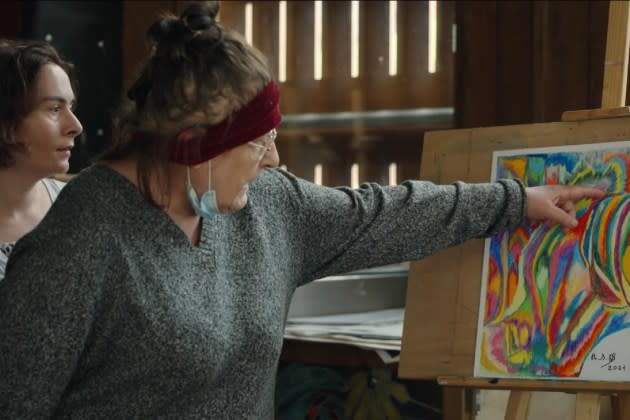‘On the Adamant’ Review: Nicolas Philibert’s Touching Exploration of Creativity and Mental Illness
- Oops!Something went wrong.Please try again later.
- Oops!Something went wrong.Please try again later.

The observant documentaries of Nicolas Philibert, which include such films as Louvre City, In the Land of the Deaf and his 2002 hit, To Be and To Have, often focus on either a single character or location — the latter usually a French public institution — exploring them with painstaking detail and plenty of compassion.
For his eleventh feature, On the Adamant (Sur l’Adamant), the 72-year-old filmmaker spent months aboard a barge anchored on the Seine in Paris, chronicling a mental health care facility that caters specifically to its patients’ creative needs. What emerges is not only a depiction of psychiatric treatment administered with plenty of warmth and enthusiasm, but a portrait of several individuals who, despite their noticeable disabilities, are capable of producing original and moving works of art.
More from The Hollywood Reporter
'Here' Review: Belgian Drama's Poetic Gaze Is Low-Key and Profoundly Affecting
'Klondike' Review: A Harrowing Ukrainian Drama Set at the Start of the War
'Our Body' Review: Claire Simon's Intimate and Unflinching Look Inside a French Gynecology Ward
Like his contemporaries Frederick Wiseman and Raymond Depardon, both whom live in France as well, Philibert never provides voiceover or explanatory titles in his movies, and rarely do they feature interviews (though his latest includes a few talks with patients). They are more like discreet immersive experiences, and therefore the opposite of the shock-and-awe docs currently popular on Netflix and other streamers. After premiering in Berlin’s main competition, On the Adamant will be released at home and hopefully garner some attention abroad.
Philibert, who typically serves as his own cameraman, points his lens at the Centre de jour l’Adamant, a floating psychiatric facility in central Paris where patients go to participate in activities like cooking, drawing, painting, borrowing books and making music, as well as completing basic tasks like running the cash register. This being France, the Centre also has its very own café, as well as a ciné-club where movies by Federico Fellini, Abbas Kiarostami and Woody Allen are screened and discussed.
The film begins with a man belting out the 1979 French rock hit “La bombe humaine” by the band Telephone, in a performance that speaks to both the passions of the Centre’s patients and the fact that, more often than not, their mental handicaps can hide their true creativity from the public eye. “You hold the human bomb in your hand/The trigger is right next to your heart,” the song goes, and it’s a fitting introduction to a place where talents are nurtured, cultivated and then unleashed.
This happens musically, such as when we see another man perform an original song that’s worthy of, and very much inspired by, The Doors. Or else visually when we watch patients produce colorful works of art that they discuss in group sessions, explaining what the images reveal about their own lives.
“Art therapy” is perhaps an overused term, but in On the Adamant it actually seems to work. Not because the patients are necessarily cured — some of them have serious conditions that require medication and occasional hospitalization — but because art helps them not only to live with their handicaps, but to harness them for creation.
The barge’s location is definitely a major part of this: Anchored nearby the Gare de Lyon, it’s a short walk from the Louvre, the Musée d’Orsay and the Bibliothèque Nationale, as well as other cultural landmarks. For patients who inhabit that part of the city, or else commute into town for treatment at the centre, they’re smack in the middle of one of the world’s greatest museum epicenters. Creating therefore comes as naturally to them as surfing would to someone in Malibu or banking to someone in Geneva, and even if they’re not necessarily fit for regular working life, they’re fit to be artists.
Sometimes the patients turn away from their activities to address the camera directly, and we begin to grasp how troubled or traumatized some of them really are. But even those monologues have a poetic ring to them, not to mention a fair amount of humor and self-deprecation, forcing us to look past the their diagnosed conditions to see the personalities hiding behind.
With plenty of subtlety, because Philibert never overstates things — if anything he understates them, especially for viewers who like their documentaries spelled out loud and clear — the film unveils the creativity inherent in all individuals, including those with severe enough problems to require professional care.
By documenting the daily routine of a place most Parisians walk by without ever noticing (and that includes this reviewer), On the Adamant becomes a moving testament to what people are capable of, if they could just find the right outlet for it.
Best of The Hollywood Reporter
13 Times Hollywood Predicted the Scary (or Not So Scary) Future of AI
Kim Cattrall and Five Actors Who Made Surprising Returns to a Role

